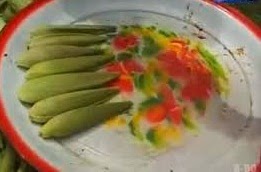KATUPAT KANDANGAN
 Ketupat Kandangan cuisine, is a typical food from southern Borneo Kandangan City District Upper South River.For the tongue of Banjar, katupat Kandangan a preferred food, especially for breakfast so Katupat Kandangan food stalls spread everywhere in the city of Banjarmasin either alone, or in the home town of the Kandangan cuisine.
Ketupat Kandangan cuisine, is a typical food from southern Borneo Kandangan City District Upper South River.For the tongue of Banjar, katupat Kandangan a preferred food, especially for breakfast so Katupat Kandangan food stalls spread everywhere in the city of Banjarmasin either alone, or in the home town of the Kandangan cuisine.
For people eating Kandangan should use a hand, because if you use it less tasty spoon, while the others were still using a spoon.
The hallmark of this food is rice cake which split apart and then presented to the new plate or bowl given gravy made of coconut milk is thick, and must use Haruan well with fish head, tail, or middle of the meat, or fish entrails (mixed grated egg Haruan fish).
Another side dish that can be used only chicken eggs or duck eggs.
ingredients:
* 6 pieces of diamond, cut into pieces
* 750 grams of fresh catfish, discarded his head
* 1 teaspoon tamarind
* 1 teaspoon salt
* 1 teaspoon lemon juice
* 5 pieces of lime leaves, torn
* 2 stalks lemongrass, crushed
* 1,500 ml coconut milk from 1 coconut
* 6 tablespoons oil for sauteing
Spices:
* 10 grains of red onion
* 4 cloves of garlic
* 3 eggs hazelnut
* 1/2 teaspoon coriander
* 1 cm ginger
* 3 cm turmeric
* 1/4 teaspoon pepper
* 1/2 teaspoon shrimp paste
* 4 3/4 teaspoon salt
* 1 cm galangal
* 1/8 teaspoon cumin
* 2 teaspoons granulated sugar
Ingredients sauce:
* 5 pieces of red chilli
* 2 pieces of cayenne pepper
* 1/2 teaspoon shrimp paste fried
* 1 tomato
* 1/2 teaspoon salt
* 1/4 teaspoon pepper
* 2 tablespoons oil for sauteing
How to make:
1. Marinate the fish with tamarind, salt, and lime juice.
2. Let stand 45 minutes.
3. Bake the fish in the coals until cooked.
4. Saute ground spices, lime leaves, and lemongrass until cooked.
5. Pour the coconut milk and bring to a boil.
6. Enter catfish. Boil until the flavors to infuse.
7. Serve with rice cake.
8. Sambal, fried chili, shrimp paste, red onions, and tomatoes until fragrant.
9. Lift then add the salt, and pepper. Puree.
10. Serve with diamond Kandangan.
Another side dish that can be used only chicken eggs or duck eggs.
ingredients:
* 6 pieces of diamond, cut into pieces
* 750 grams of fresh catfish, discarded his head
* 1 teaspoon tamarind
* 1 teaspoon salt
* 1 teaspoon lemon juice
* 5 pieces of lime leaves, torn
* 2 stalks lemongrass, crushed
* 1,500 ml coconut milk from 1 coconut
* 6 tablespoons oil for sauteing
Spices:
* 10 grains of red onion
* 4 cloves of garlic
* 3 eggs hazelnut
* 1/2 teaspoon coriander
* 1 cm ginger
* 3 cm turmeric
* 1/4 teaspoon pepper
* 1/2 teaspoon shrimp paste
* 4 3/4 teaspoon salt
* 1 cm galangal
* 1/8 teaspoon cumin
* 2 teaspoons granulated sugar
Ingredients sauce:
* 5 pieces of red chilli
* 2 pieces of cayenne pepper
* 1/2 teaspoon shrimp paste fried
* 1 tomato
* 1/2 teaspoon salt
* 1/4 teaspoon pepper
* 2 tablespoons oil for sauteing
How to make:
1. Marinate the fish with tamarind, salt, and lime juice.
2. Let stand 45 minutes.
3. Bake the fish in the coals until cooked.
4. Saute ground spices, lime leaves, and lemongrass until cooked.
5. Pour the coconut milk and bring to a boil.
6. Enter catfish. Boil until the flavors to infuse.
7. Serve with rice cake.
8. Sambal, fried chili, shrimp paste, red onions, and tomatoes until fragrant.
9. Lift then add the salt, and pepper. Puree.
10. Serve with diamond Kandangan.






